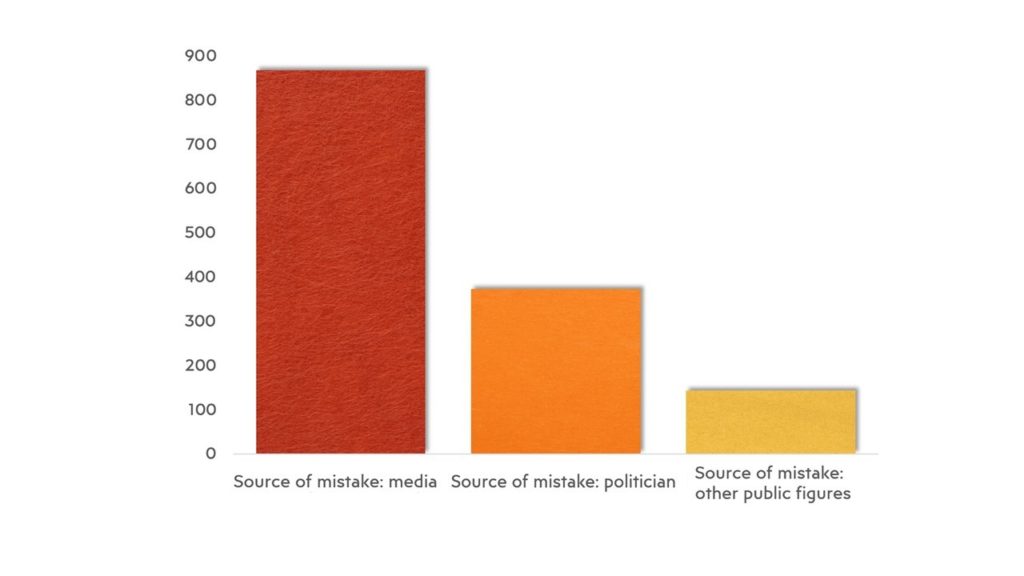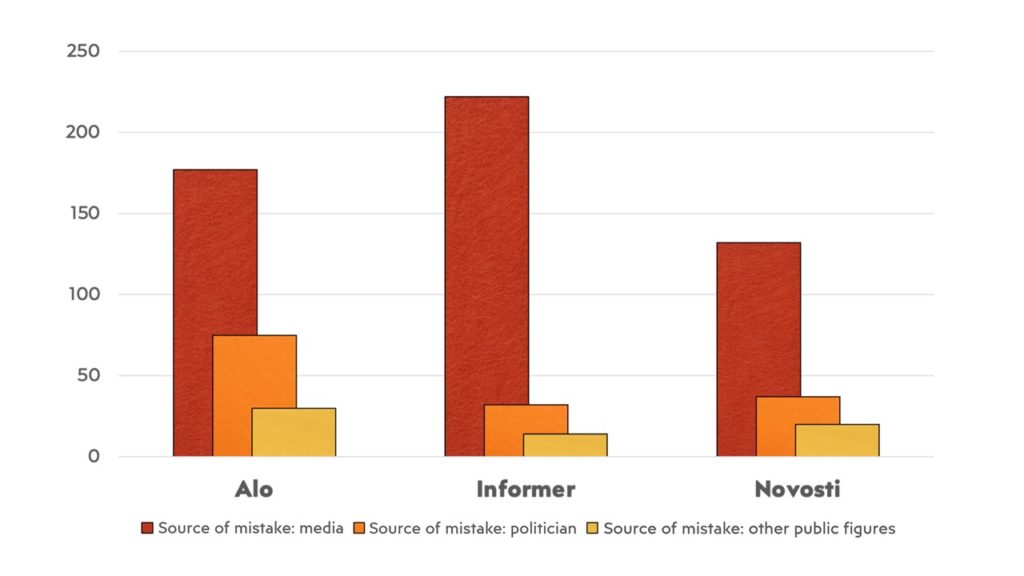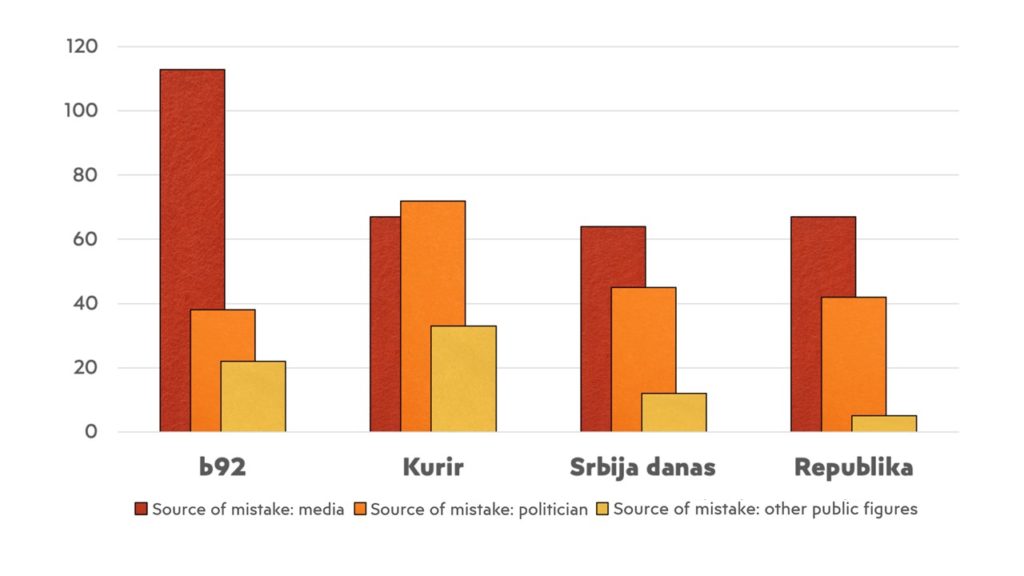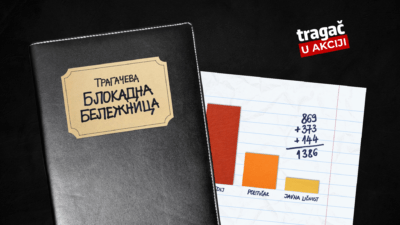Original article (in Serbian) was published on 5/3/2025; Author: FakeNews Tracker editorial office
The editorial team of FakeNews Tragac decided to adopt a modified approach to work ahead of the general strike on January 24 of this year, which involved almost daily reporting on the manipulations of the most-read domestic web portals regarding students, faculty blockades, and protests across Serbia. At that time, we launched Tragac’s blockade notebook, recording 26 notes about the most striking manipulations by these web portals until March 3rd. These notes were based on more than 1,300 manipulative news articles, and today, we reveal which web portals manipulated the most and how the media we analyzed reported on the student uprising.
Over the course of 40 days (from January 23 to March 3), we recorded exactly 1,386 manipulative news articles in our blockade notebook. In addition to noting which media outlet published them, we categorized the articles in three other ways. We documented whether the source of manipulation was in the media text itself, or in a statement that was reported about, and we further distinguished between statements made by politicians and those made by other public figures, such as analysts, professors, or celebrities.
Which media did we analyze?
We analyzed the 15 most-read news web portals according to the Gemius ranking on January 23, 2025. At that time, these web portals were: Blic, Kurir, Mondo, Espreso, Srbija danas, Alo, Informer, Novosti, Direktno, N1, Nova, Danas, Telegraf, B92, and Republika.
The result?
In most cases (869), the media themselves were responsible for creating manipulations, whether through original content or by republishing material from other outlets. In 373 cases, the manipulation stemmed from a statement made by a politician, while 144 such articles were based on misleading statements from other public figures.

Don’t worry, we are not shutting down our blockade notebook, it is simply changing its format. As we mentioned in Note 26, from now on, the notebook will focus on news from the three web portals that engaged in the most manipulation during the first 40 days of our analysis: Alo, Informer, and Novosti.
For more information about their reporting, as well as that of other websites, continue reading as we have provided a ranking list. At the top is the web portal that used manipulation the most, while at the bottom are those that either did not report on students and protests at all or did so in a responsible manner.

1. Alo
The highest number of manipulative news articles during the first 40 days of the blockade notebook was found on the web portal Alo. The total number of such articles reached 282, of which 177 contained manipulations either created by the media itself or republished from another outlet. Alo repeatedly presented its own speculations, such as the fake claim that protesters blocked the Emergency Center in Belgrade on February 4, preventing ambulances with sirens on from passing through. Later, the web portal also published the (dis)information about “student leaders with VIP status” who supposedly arrived at protests by taxi, an exclusive revelation, according to the web portal. While Alo may not have been the most creative in fabricating manipulations about students, it made up for this by publishing the highest number of such articles, compensating for its lack of originality by amplifying manipulations from politicians and public figures.
2. Informer
If we set aside the republishing of manipulative content from politicians and other public figures, Informer takes the top spot on our list. We detected as many as 222 articles where the source of manipulation was the media itself. Additionally, there were 46 inaccurate and manipulative news articles based on misleading statements. However, in total, Informer published slightly fewer manipulative articles about students than Alo. During the observed period, Informer stood out by inventing “Gruhonjic’s insiders”, who were supposedly pushing for a transitional government in student plenary meetings. The web portal also falsely reported upcoming bloody clashes in Novi Sad (which never happened) and published alleged poll results on Vucic’s popularity, where, instead of conducting an actual public opinion survey, they simply polled seven of Vucic’s supporters. Beyond all these issues, Informer’s manipulative articles were also notoriously poorly written, often containing multiple spelling mistakes, even in headlines.
3. Novosti
Vecernje Novosti, which earned the bronze medal on our ranking, published 189 problematic articles about blockades and protests during the observed period. In 132 cases, the source of manipulation was the media itself or another outlet from which the information was republished. 37 articles were based on misleading statements by politicians, while 20 articles contained manipulations from other public figures. Novosti demonstrated a low level of creativity and originality, as their loyal audience had likely already encountered most of the inaccurate content, often in an identical format, on similar but faster news web portals. This tabloid attempted to prove that the ongoing protests are actually a rebellion of the rich. It also downplayed an incident in which a doctor was allegedly unharmed when a car sped through a protest in front of the Institute for Mental Health, despite the Ministry of Internal Affairs confirming that two women were hit.

4. B92
The web portal B92 published as many as 173 misleading articles about students between January 24 and March 3. The majority of them, 113 in total, were based on manipulations originating from the media. The specificity of B92 is primarily reflected in its “copying” of deceptions and speculations devised by other media, which the authors of the texts often acknowledged in their articles. For example, the claim that student plenary meetings are “controlled forums where those who disagree with the views of a small group of organizers are not allowed to attend” was taken by B92 from the web portal 24sedam. Meanwhile, the unfounded information that Milo Djukanovic is financing protests in Serbia was taken from the media outlet Alo.
5. Kurir
While the total number of manipulative news articles published by Kurir stands at 172, it is important to emphasize that this media outlet more frequently shared manipulations in the form of statements from politicians (77) and public figures (33) rather than actively participating in their creation or in sharing manipulations from other media (67). For example, Kurir uncritically and without prior verification published a statement by President Aleksandar Vucic, in which he claimed that at a conference the previous day, “Trump directly mentioned Serbia as a place where those who gave American money for overthrowing the government, wanted a change of that government” (speaking of money received by NGOs). This statement was soon proven to be manipulative. In this regard, a particularly noteworthy example is when this web portal published the opinion of a certain “eyebrows king”, Branko Babic, who claimed that the students’ demands had been met, despite the fact that this was not true.
6. Srbija danas
The web portal Srbija danas published 121 manipulative articles about students, blockades, and protests during the analyzed period. More than half of these (64) were based on manipulations from that or another media outlet. Among the remaining misleading articles, those featuring manipulations spread by politicians were dominant (42 articles). Similar to B92, Srbija danas particularly stood out for its “copying”, as almost none of the manipulative articles analyzed were created by this web portal itself. The exception were misleading news reports published on January 24 (the day of the general strike), which claimed that all establishments were open and that “everything was the same as any other day” – these were created by the journalists of this outlet. At the same time, this media outlet was most actively engaged in manipulating during the general strike and in the days following it. Over time, however, it gradually lost interest in publishing news about the protests and increasingly relied on statements from politicians.
7. Republika
The web portal of the tabloid Srpski telegraf, Republika, is the last media outlet on this list where we recorded more than 100 problematic articles related to student protests and blockades. Out of a total of 114 such articles, 67 exhibited subtle manipulation either by this or another media outlet. After the protest in Nis, “Studentski edikt”, the mentioned web portal published news with the provocative headline “HERE’S HOW MANY PEOPLE WERE REALLY AT THE PROTEST IN NIŠ: The square was almost empty”, in which it shared a misleading photograph and only cited an estimate made around 1 PM, without revealing the source in the text. Similarly, without transparent evidence or named sources, they rushed to publish that the girl who was hit by a car during the protest on January 25 was “fine”, even though the only official information at that moment was that she was “conscious and communicative” and that diagnostics were still ongoing.
Web portals where we recorded a lower number of manipulations
The web portal Telegraf ranks eighth on our list, with 29 published manipulative news articles. This is a significantly lower number compared to the seventh-ranked web portal, Republika, which published over a hundred. Additionally, a large portion (27 out of 29) of the manipulative articles we identified on Telegraf were statements made by politicians, which this media outlet reported without any disclaimers.
In ninth and tenth place are the web portals Nova and Direktno, which published only a few manipulative articles about blockades and protests, despite dedicating considerable attention to these events. These mostly consisted of exaggerations, such as baseless claims about the “largest gathering” in a particular location or false information stating that in a certain city, “not a single school is open”.
The web portal Blic and Mondo took a similar approach to reporting on protests and blockades: they covered the topic less frequently than their competitors, but their published articles contained almost no manipulative elements (we recorded only a few manipulative articles on Blic and none on Mondo). Their writing style on this topic was quite close to an agency-style approach: factual, distanced, concise, without sensationalism or manipulation. Almost the same applies to the web portal Espreso, which rarely reported on any political topics, including protests and blockades.
On the other hand, the web portal Danas recorded a similarly small number of manipulative articles but with an incomparably higher volume of production, genre diversity, and level of engagement. The same can be said for the web portal N1, which covered student protests and blockades even more thoroughly, with the support of its field reporters, maintaining a live blog during each major protest.



